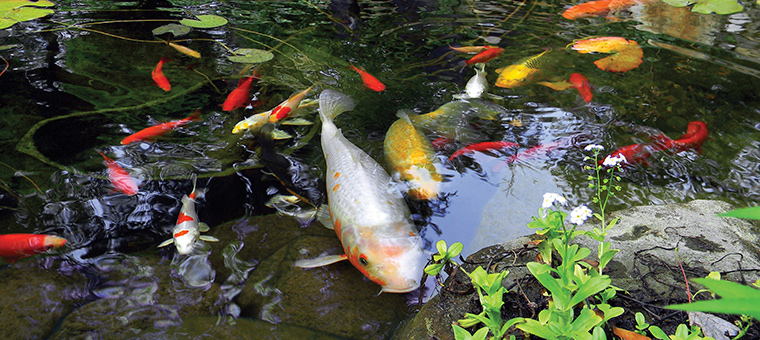Ponds 101 Chapter 3
The Koi Pond
Koi, or more properly, nishikigoi, are descended from carp originally bred for food in the Far East, where first Chinese, then Japanese fish farmers noticed colorful mutations in the fish they raised for the table and started developing the highly prized jewels we know today. These large and long-lived fish have distinctive personalities that endear them to their owners over their long lives, which often span many decades under ideal conditions. (How old can they live? Well, when Hanako, a scarlet female in Japan, passed away in 1977, she was 226 years young!) Their digestive tracts are no longer as efficient as their wild cousins; they need to be fed and cared for, and the large amount of food they eat can easily foul the water they live in. In Japan the water quality of these ponds was often ensured by having a constant flow of clean water flushing away the copious wastes Koi produce; that’s impossible here. Even if there were access to a constant supply of clean, non-chlorinated water, the flow out of the pond would be considered polluted by most municipal and federal environmental agencies. Koi Ponds need relatively intensive circulation and filtration to stay clear and clean, and their prodigious vegetarian appetites make keeping plants a challenge, so phytofiltration, the use of plants as filters, is often considered impossible. (Actually, it’s not impossible at all – we’ll be discussing Natural Filtration in our College of Filtration ) In general, Koi ponds rely on large pumps and extensive filtration, and it’s all about the Koi; no plants or other critters need apply.

Typical Koi Pond
Koi, or more properly, nishikigoi, are descended from carp originally bred for food in the Far East, where first Chinese, then Japanese fish farmers noticed colorful mutations in the fish they raised for the table and started developing the highly prized jewels we know today. These large and long-lived fish have distinctive personalities that endear them to their owners over their long lives, which often span many decades under ideal conditions. (How old can they live? Well, when Hanako, a scarlet female in Japan, passed away in 1977, she was 226 years young!) Their digestive tracts are no longer as efficient as their wild cousins; they need to be fed and cared for, and the large amount of food they eat can easily foul the water they live in. In Japan the water quality of these ponds was often ensured by having a constant flow of clean water flushing away the copious wastes Koi produce; that’s impossible here. Even if there were access to a constant supply of clean, non-chlorinated water, the flow out of the pond would be considered polluted by most municipal and federal environmental agencies. Koi Ponds need relatively intensive circulation and filtration to stay clear and clean, and their prodigious vegetarian appetites make keeping plants a challenge, so phytofiltration, the use of plants as filters, is often considered impossible. (Actually, it’s not impossible at all – we’ll be discussing Natural Filtration in our College of Filtration ) In general, Koi ponds rely on large pumps and extensive filtration, and it’s all about the Koi; no plants or other critters need apply.

Typical Koi Pond




